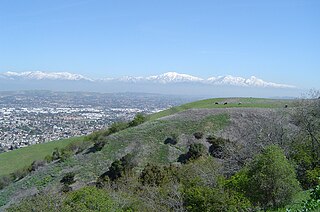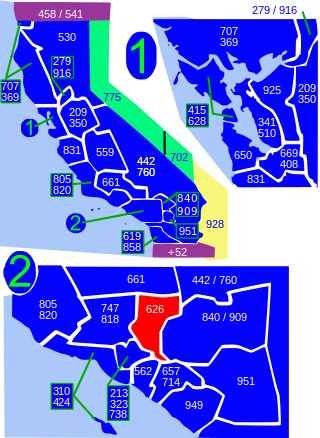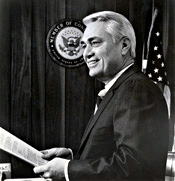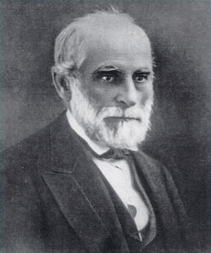
Azusa is a city in the San Gabriel Valley region of Los Angeles County, California United States at the foot of the San Gabriel Mountains located 20 miles (32 km) east of downtown Los Angeles.

El Monte is a city in Los Angeles County, California, United States. The city lies in the San Gabriel Valley, east of the city of Los Angeles.

Rosemead is a city in Los Angeles County, California, United States. The 2020 United States Census reported a population of 51,185. Rosemead is part of a cluster of cities, along with Alhambra, Arcadia, Temple City, Monterey Park, San Marino, and San Gabriel, in the west San Gabriel Valley with a growing Asian-American population.

The San Gabriel Valley, often referred to by its initials as SGV, is one of the principal valleys of Southern California, with the city of Los Angeles directly bordering it to the west, and occupying the vast majority of the southeastern part of Los Angeles County. Surrounding landforms and other features include the following:
The San Gabriel Valley Tribune is a paid daily newspaper located in Monrovia, California, that serves the central and eastern San Gabriel Valley. It operated at the West Covina location from 1955 to 2015. The Tribune is a member of Southern California News Group, a division of Digital First Media. It is also part of the San Gabriel Valley Newspaper Group, along with the Pasadena Star-News and the Whittier Daily News.

The Rio Hondo is a tributary of the Los Angeles River in Los Angeles County, California, approximately 16.4 miles (26.4 km) long. As a named river, it begins in Irwindale and flows southwest to its confluence in South Gate, passing through several cities. Above Irwindale its main stem is known as Santa Anita Creek, which extends another 10 miles (16 km) northwards into the San Gabriel Mountains where the source, or headwaters, of the river are found.

Located in Los Angeles County, California's San Gabriel Valley, the Boy Scouts of America's San Gabriel Valley Council (#40) was one of five councils serving Los Angeles County. It was headquartered in Pasadena.

Area code 626 is a telephone area code in the North American Numbering Plan for most of the San Gabriel Valley in the U.S. state of California. The numbering plan area also comprises nearby areas in the northeastern portion of Los Angeles County, California, including Arcadia, Monrovia, El Monte, most of Pasadena and West Covina. The numbering plan area was split from that of area code 818 on June 14, 1997.
The Southern California Association of Governments (SCAG) is the Metropolitan Planning Organization (MPO) of six of the ten counties in Southern California, serving Imperial County, Los Angeles County, Orange County, Riverside County, San Bernardino County, and Ventura County. San Diego County's MPO is the San Diego Association of Governments, which is an unrelated agency.
Rancho San Jose was a 22,340-acre (90.4 km2) Mexican land grant in northeastern Los Angeles County given in 1837 by Governor Juan Bautista Alvarado to Ygnacio Palomares and Ricardo Véjar. Today, the communities of Pomona, LaVerne, San Dimas, Diamond Bar, Azusa, Covina, Walnut, Glendora, and Claremont are located in whole or part on land that was once part of the Rancho San Jose.

Charles Edward Wiggins was a United States representative from California, and later a United States circuit judge of the United States Court of Appeals for the Ninth Circuit. He was initially elected to California's 25th congressional district. The district was renumbered as California's 39th congressional district prior to the 1974 election.
Rancho Azusa de Dalton,, was a 4,431-acre (17.93 km2) Mexican land grant in present-day Los Angeles County, California, given in 1841 by Governor Juan Alvarado to Luis Arenas. Arenas sold his Rancho Azusa de Duarte holdings three years later to Henry Dalton (1803–1884), a wealthy merchant from Pueblo of Los Angeles. Dalton named his holding Rancho Azusa de Dalton. Henry Dalton was also called Don Enrique Dalton.
Rancho Azusa de Duarte was a 6,596-acre (26.69 km2) Mexican land grant in present-day Los Angeles County, California given in 1841 by Governor Juan Alvarado to Andres Duarte, a former Mexican corporal. Cities that have been established on the Rancho lands originally granted to Andres Duarte include Arcadia, portions of Monrovia, all of Bradbury, all of Duarte, portions of Irwindale, portions of Azusa and a portion of Baldwin Park.

Savannah is a former settlement in Los Angeles County, California. The rail depot of that name was located on the line of the Southern Pacific Railroad between San Gabriel and El Monte, at an elevation of 276 feet.

Andrew Jackson King, or A. J. King, was a lawman, lawyer, legislator and judge in 19th Century Los Angeles County, California.
Rancho San Francisquito was a 8,894-acre (35.99 km2) Mexican land grant in present day Los Angeles County, California given in 1845 by Governor Pio Pico to Henry Dalton. The grant included present day cities of El Monte, Irwindale, and Temple City.

Susan Rubio is an American politician serving in the California State Senate. She represents the 22nd Senate District in eastern Los Angeles County and is a member of the Democratic Party. Prior to being elected to the California Legislature in 2018, she was an elected official for the City of Baldwin Park for 13 years and a public school teacher for 17 years.

Santa Fe Trail Historical Park, also called Pioneer Park, is located on the bank of the Rio Hondo River in El Monte, California. The location was designated a California Historic Landmark on Aug. 13, 1987. This was originally an encampment on the Old Spanish Trail. The Old Spanish Trail was an extension of the trail from Missouri to Santa Fe, New Mexico. The Gila River trail also ended in El Monte. By the 1850s, those in El Monte started to call the town the `End of the Santa Fe Trail." This claim is disputed by some, such as the Santa Fe in New Mexico. In the 1800s permanent settlements were established by immigrants from Texas and Arkansas, the first settlement in Southern California founded by citizens of the United States. The state marker for the Santa Fe Trail Historical Park is located at 3564 Santa Anita Ave, El Monte, CA 91731. The City of El Monte held a ceremony to dedicate the Santa Fe Trail Historical Park on June 2, 1989.
















